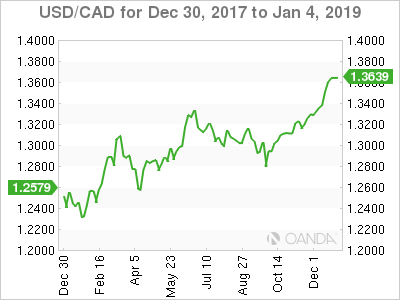As we bid adieu to 2018 and welcome in a New Year, USD/CAD is unchanged. Currently, the pair is at 1.3638, down 0.01% on the day. On Friday, USD/CAD touched its high of the year, at 1.3661. There are no U.S. or Canadian events until Wednesday.
It was a brutal year for the Canadian dollar, as the commodity currency plunged 7.6 percent. The currency started the year in promising fashion, posting gains of 2.1 percent in January. However, the currency slid in February, falling 4.2 percent. After trading in a narrow range for most of the second and third quarters, the Canadian dollar has struggled in Q4, dropping 5.6 percent.

Open: 1.2579 High: 1.3661 Low: 1.2249 Close: 1.3612
I am bearish on the Canadian dollar
Tumultuous equity markets have led to increased risk apprehension, as jittery investors have flocked to safe-haven assets, at the expense of minor currencies like the Canadian dollar. USD/CAD has posted six straight losing weeks. The December slide was punctuated only by the Christmas holidays, with investors taking some time off. The global trade war, which has resulted in more tariffs on Canadian exports, will continue to hamper the Canadian economy. However, this stark situation could quickly change if the U.S. and China come to an agreement on trade issues which have led to tit-for-tat tariffs between the world’s largest two economies.
Another factor weighing on the Canadian currency is the steep decline in oil prices. WTI Crude has fallen to $45 a barrel, plunging some 40% in the past three months. a weakened global economy could mean that oil prices remain depressed for the foreseeable future. If oil prices remain depressed, traders can expect more headwinds for the Canadian dollar, which is a commodity currency.













